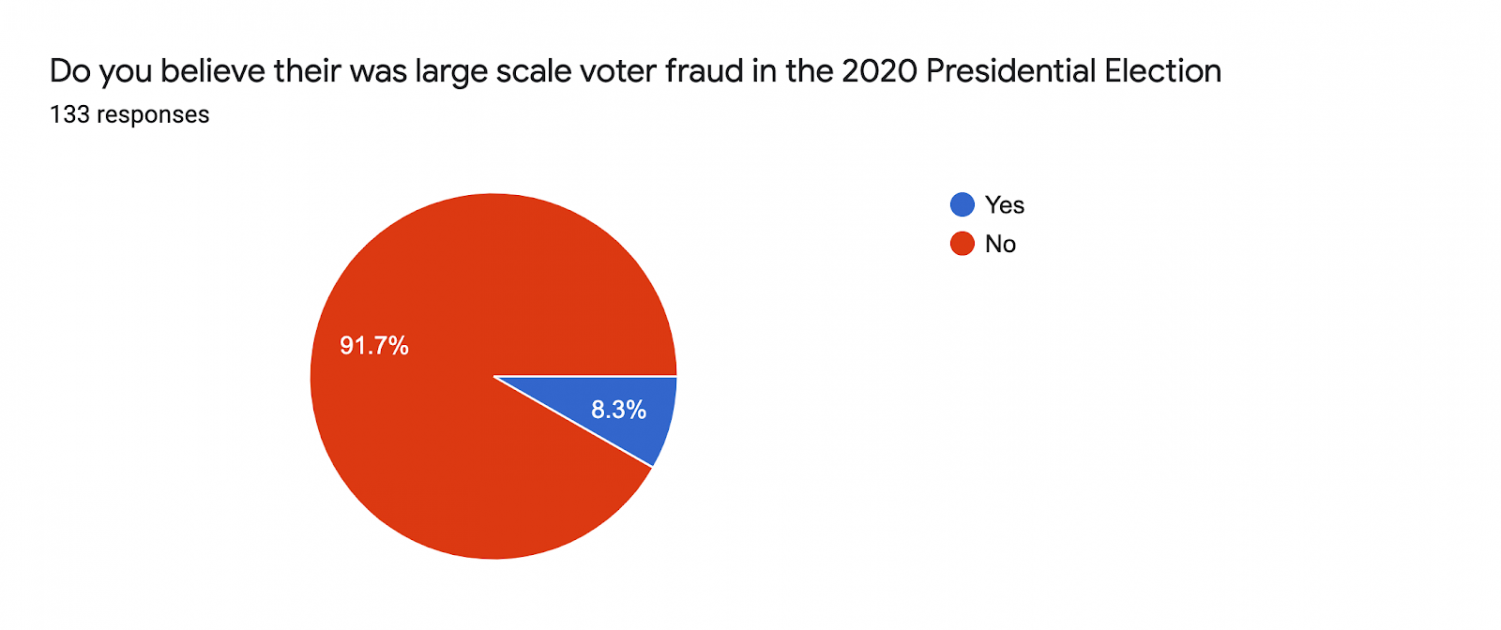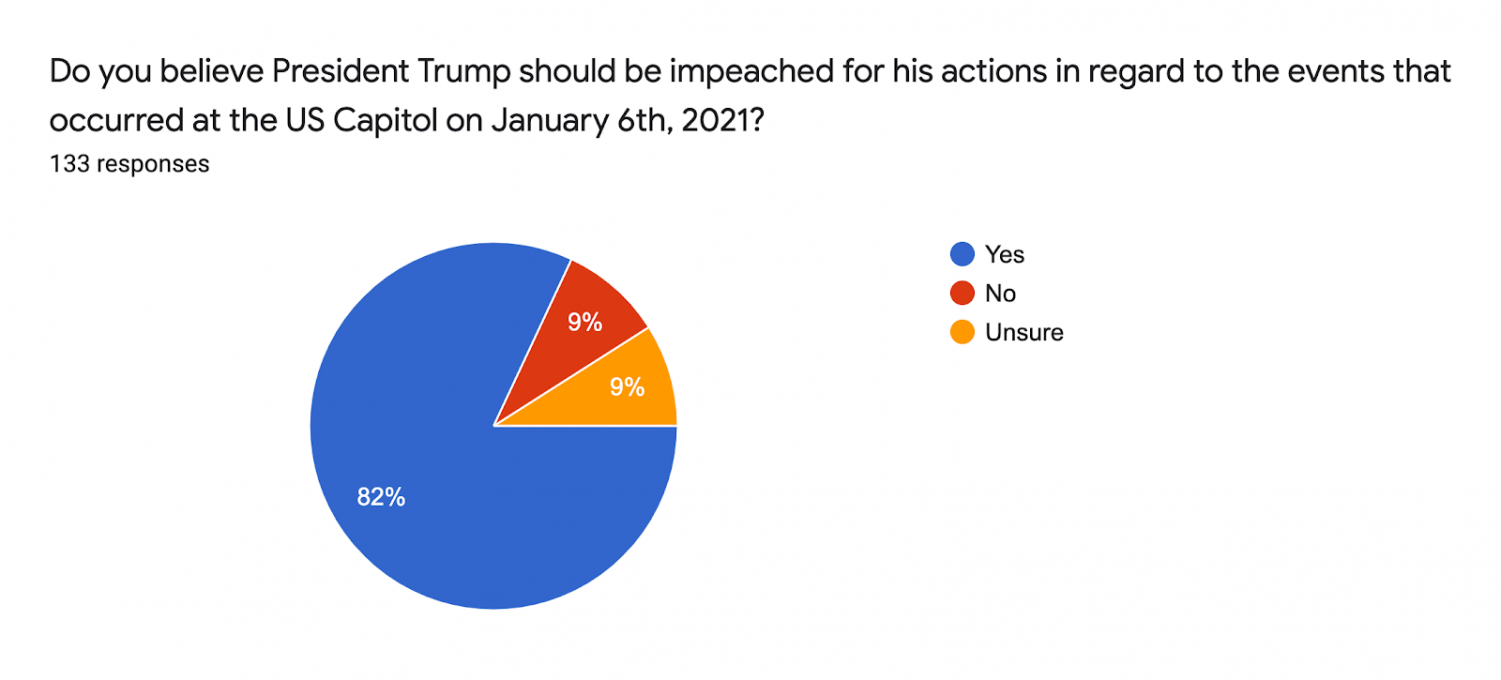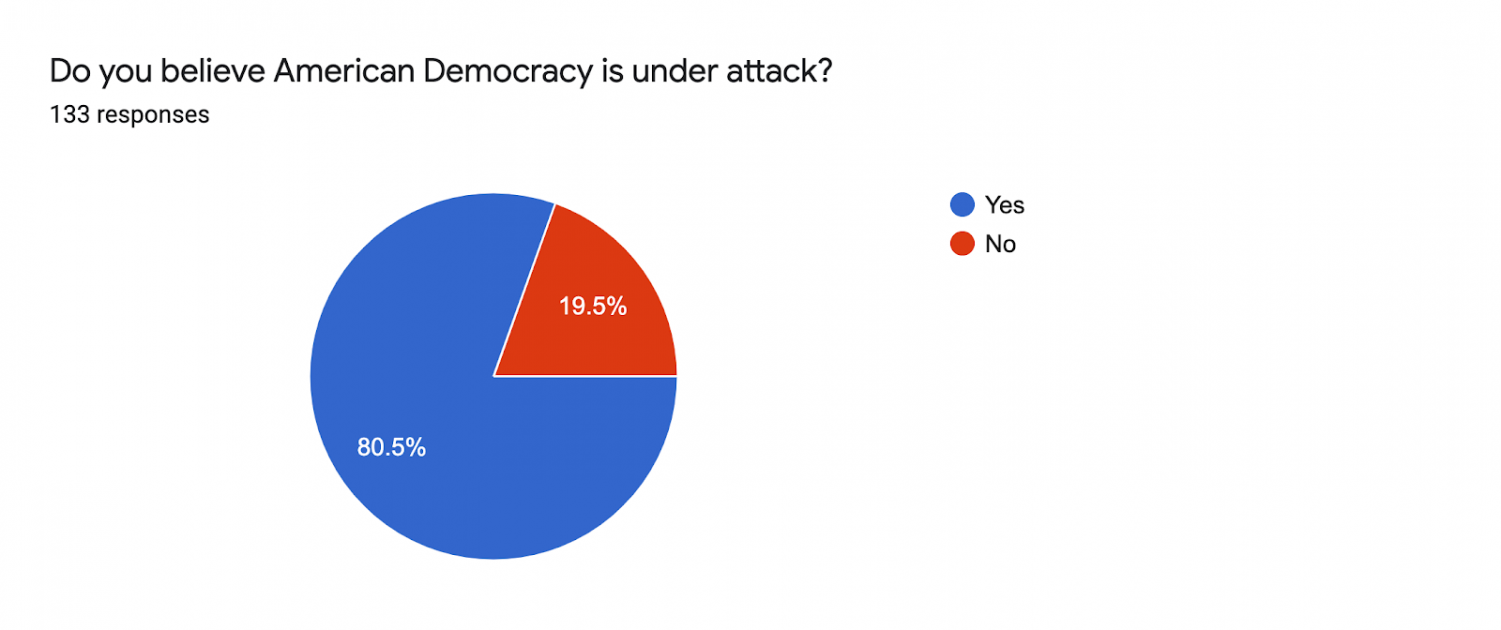American democracy under attack: the Capitol riot from the eyes of Schreiber students
What was supposed to be a protest by Trump supporters voicing their opinions regarding the presidential election, turned into a violent, armed insurrection on Capitol Hill on Jan. 6. They gathered outside the Capitol to protest the election results as Congress counted the electoral vote and confirmed Joe Biden as the president-elect of the United States.
Biden won the presidency on Nov. 7, 2020 and defeated Donald Trump by a popular vote margin of about 7 million votes and an electoral vote margin of 74 electoral votes. Shortly after, Trump launched a campaign to overturn the results of the election, claiming it was rigged and “stolen from him.” After multiple failed lawsuits and a lack of unification from the Republican party to overturn the election, Trump has continued to falsely claim that he won the election by a landslide.

Earlier on the day of the attack, President Trump held a rally outside of the White House, where Trump told his supporters, “We will never concede.”
The process to count the electoral votes had just commenced when the Capitol went into lockdown as rioters began to swarm and enter the building. The mob broke through the barricades and entered the east side of the building, screaming and demanding that their opinion be heard.
At 2:15 p.m., Vice President Mike Pence was rushed out of the Senate chamber by security, and some senators and representatives hid under tables, unsure of what would follow. Following this, the mayor of Washington D.C., Muriel Bowser, declared that there would be a 12-hour curfew starting at 6:00 p.m. in the D.C. area.
The violent protestors had an armed standoff with Capitol police, who built barricades behind doors to prevent mass entry into the building. The mob smashed windows, put clothing on statues, took photos in the offices that they broke into, and even hung from the balcony in the Senate chamber.
Outside the Capitol, the police deployed tear gas on the rioters, and eventually, the National Guard arrived on the scene. They cleared out the building and the steps, but there was still a group of Trump supporters protesting.
In the midst of the violence, Biden gave a speech about decency and moving forward. He also urged President Trump to step up, and said while addressing the country, “He needs to fulfill his oath and defend the Constitution and demand an end to this siege.”
Soon after, a taped video message from President Trump aired, in which he told his supporters to “go home” and end the violence. However, he continued to falsely claim to the American public that the election was fraudulent and that he was the winner in addition to telling the rioters, “We love you. You’re very special.”
To conclude what many historians labeled one of the worst days in modern American history, four rioters died during the siege, one police officer died in a hospital from injuries sustained during the attack, and two other police officers have committed suicide. The question that now looms over America—will we be able to move forward as one nation or will the division forever tear us apart?
As the Trump Presidency came to a tumultuous conclusion, moderate Republicans began to distance themselves from President Trump. As expected, the Democratic Party universally condemned the actions of the rioters and blamed Trump for the insurrection. However, the reaction coming from the right side of the political spectrum was more nuanced. This is likely because of the newly-forming schism in the Republican party between “Trumpers” such as Senator Ted Cruz (R-TX), and “Never-Trumpers” like Senator and former Presidential Candidate Mitt Romney (R-UT).
Democrats immediately took full advantage of these cracks in the Republican party, as the third-ranked Republican in the House of Representatives — Liz Cheney (R-WY) — voted for the sole article of impeachment against Trump, along with nine of her fellow Republicans. In comparison, zero Republicans voted to impeach Trump in 2019. Although obtaining a conviction in the Senate appears to be an uphill battle for Democrats, especially with Trump already out of office, even Senate Minority Leader Mitch McConnell stated that Trump “provoked” the Capitol riots. Many view this as a way to save face, as Senator McConnell has backed Trump through controversy throughout this Presidency, but it could signal a shift of the Republican party away from Trump.
Moreover, during the summer of 2020, following the murders of George Floyd, Breonna Taylor, Jacob Blake, and Ahmaud Arbery, the nation erupted into protests focusing on equality and police discrimination against African Americans. In opposition to the Black Lives Matter protests came chants of “Back the Blue” from some conservatives, especially right-wing extremists, such as those who stormed the Capitol on Jan. 6.
Comparisons between Black Lives Matter protests and the attack on the Capitol have been made by both sides. Conservatives are highlighting the few Black Lives Matter protests that turned violent, with the looting of stores and the burning of a police precinct in Minneapolis. However, according to Time magazine, 93% of these protests were peaceful. In response, Trump critics are categorizing the events that took place on Jan. 6 as a malicious act of domestic terrorism, arguing that white supremacists and conspiracy theorists purposefully invaded the Capitol to overturn the election and murder politicians.
Former President Trump’s reactions towards these events were profoundly different. Trump responded to the Black Lives Matter protests with a tweet that included the line, “When the looting starts, the shooting starts.” This line was made famous by a Miami police chief and known segregationist in the 1960’s, who drew ire from the leaders of the civil rights movement.
In a way, the Black Lives Matter movement is a modern civil rights movement, attempting to bring an end to systemic racism, and the National Guard tear-gassed peaceful protesters during a BLM protest in front of the White House, so that former President Trump could cross the road to visit a church for a photo-op. This clear abuse of power infringed the Black Lives Matter protesters’ First Amendment right to a peaceful protest. In stark contrast, as noted before, Trump endorsed the attackers in a speech made moments before the storming of the Capitol. During this speech, Trump said, “We will never take back our country with weakness,” which many have considered to have incited the violence that followed.
The presidential response, combined with the seeming lack of preparation for the possibility of violence at the Capitol, caused many to wonder what would have happened if the siege at the Capitol had been executed by Black Lives Matter protesters.
Newly-inaugurated President Joe Biden said, “No one can tell me that if it had been a group of Black Lives Matter protesting yesterday, they wouldn’t have been treated very, very differently from the mob of thugs that stormed the Capitol.”
Although Schreiber is 256 miles away from the Capitol, the effects of the events of Jan. 6 were clearly felt by our student body. According to a survey conducted by The Schreiber Times of 131 students, nearly 60% labeled the day’s events as either a terrorist attack or a riot, a total of 87 students. On the other hand, a mere 6 called it a protest. Many of the people who stormed the Capitol did so with the belief that President Trump defeated President Biden in the election. However, Schreiber students do not agree, as only 8.3% of respondents felt there was large scale voter fraud.
Many Schreiber students are still worried for the democratic system in America. 80.5% of respondents believe that American democracy is under attack. This may be why most students think that President Trump should have been impeached. An overwhelming 107 students believe Donald Trump deserves impeachment for inciting the riots, while only 12 believed he should not be. The process of Trump’s impeachment began on Jan. 13, when there was bipartisan support in the House, charging him with “incitement of insurrection,” making him the first president in United States history to be impeached twice after his impeachment in December of 2019 due to dealings with Ukraine.

66.9% of the respondents believe that Vice President Pence should have invoked the 25th Amendment as a result of the events at the Capitol. Clearly, the students thought Trump should have been removed from office for his actions that likely led to the events at the Capitol.
Most Schreiber students are in favor of the Senate convicting him in his upcoming trial on Feb. 8.
After the riots, some Americans thought President Trump would be able to pardon himself. However, 77.4% of the student survey said that Trump should not be able to pardon himself for his actions. President Trump did not pardon himself before leaving office, which would have led to a massive uproar.
With the ongoing pandemic and hybrid learning format, the violence at the Capitol was the newest in a list of issues teens have had to process this year. Since the insurrection, parents, teachers, and students alike have wondered how to talk and process the events that transpired and how to protect teens on social media.
After the attack, it was revealed that much of the organizing had taken place on social media platforms like Facebook, so how can teens know what information to believe and not?
Experts have said that we as a society should understand the power and responsibility of social media free speech. Before we read or share information, we should make sure it is from reputable sources so we don’t share misinformation with others.
In addition, taking a “social media detox” may also be beneficial. After the attack, many may have felt over-stimulated by the endless images of rioters desecrating Capitol properties and threatening the lives of others. In this sense, limiting how much content we consume is vital, so we can protect our mental health.

“The insurrection at the Capitol shocked and disgusted me. Productive conversations about it should focus on how we got to this point as a country and what we can do to fix those issues in the long term. I think the only way to protect against fake news is taking active steps to educate ourselves and others, and not just blindly accept everything we read or hear, because while falsehood may spread easily, truth has the power to be stronger if we put in the effort to find it,” said junior Hannah Brooks.
It is also crucial that teens talk about the injustices and systemic racism evident during the attack. According to CNN Health, the essential tips to having conversations about the events that happened are having a calm, non-judgmental space to ask questions, being honest and transparent with one another, and learning healthy coping skills.
